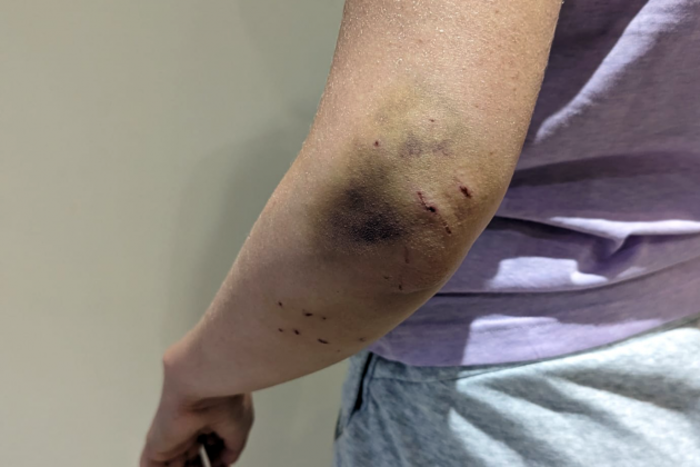Bitten and broken: Dog attack victims say lax law enforcement leaves them without hope
Noteworthy investigation finds dog bite reports continue to rise across Ireland, with sheepdogs one of the most commonly reported for aggressive behaviour.

<< WARNING: This article contains graphic images of the effects of dog bites >>
WHEN 12 YEAR-OLD Darryl Brady-Graham was savagely attacked by a dog on the restricted breeds list, his mum Deborah hoped its owner would face the full force of the law.
But in April – two-and-a-half years after the schoolboy received emergency surgery to treat the life-changing injuries to his face – the dangerous dog’s owner was handed a fine.
“The judge issued a €950 fine – tell me that is good enough for a dog that actually could have killed my son,” the north Dublin woman told Noteworthy.
“I walked out of that court that day and I felt sick. People get more of a fine for driving down a bus lane.”
This month marked three years from the terrifying attack which took place when Darryl was playing football in a park close to his Clonsilla home.
- See Darryl’s injuries here (WARNING: graphic content of lacerations)
He was set upon by a staffie/pitbull type dog after it broke free from a 14 year-old boy who had been walking the pet through the pitch.
The unmuzzled dog tore at Darryl’s face and also his arm, with the mauling so severe that the 12 year-old required 160 stitches – most to his face – and over four hours of surgery at Dublin’s Temple Street Children’s Hospital. The dog was later destroyed.
Under The Control of Dogs Regulations 1998, restricted dogs – including strains and crosses – must be kept on a short strong leash, in the control of someone over the age of 16 and muzzled in a public place.
Those found in breach of the strict rules face financial penalties, imprisonment, as well as seizure and destruction of the dog.
However, the Brady-Graham family’s horrific ordeal shows that in even in the most serious of cases, enforcement of the regulations leaves a lot to be desired.
 Darryl Brady-Graham, pictured this year, who was attacked by a dog as he played football in December 2020.
Darryl Brady-Graham, pictured this year, who was attacked by a dog as he played football in December 2020.
Noteworthy, the crowdfunded community-led investigative platform from The Journal, supports independent and impactful public interest journalism.
New figures show 60% rise in dog attacks
“I’m just blessed that he is still alive, that dog could have taken my son from me and to issue out that fine, I just feel was way too lenient,” Brady-Graham said.
“It makes me angry that the fact that the laws are actually crap when it comes to clamping down on people.”
Since the attack on young Darryl in December 2020, reports of dog attacks in Ireland have soared.
Earlier this year, the Department of of Rural and Community Development revealed that more than 300 people were injured due to a dog attack in 2022.
It was the first time statistics on aggressive behaviour and dog attacks on people reported to local authorities have been compiled.
An investigation by Noteworthy has found that the concerning rise in reports to councils has continued throughout 2023, with data showing that in some areas attacks have more than doubled.
From January to November this year, Dublin City Council received 63 reports of dogs attacking people, up from just nine reports for the entire year previous.
Reports to Wicklow County Council also saw a significant increase, with 26 people reporting they had been attacked by dogs in the 11 months of this year, compared to just six in 2022.
Dog attack incidents doubled in Cavan from four to eight, while 2023 reports to Offaly council increased six-fold, from one dog attack last year to six reports.
Of the 23 councils able to provide data, 60% reported an increase in dogs attacking people from the previous year.
There was also a significant rise in reports of aggressive dog behaviour in some council areas, with Fingal County Council receiving 88 complaints from members of the public in 2023 – up from 29 last year.
Figures provided by Louth, Tipperary, Galway City, Leitrim and Offaly councils also showed an increase in these type of reports.
In total, councils recorded 366 dog-on-dog attacks, or attacks on other animals, which occurred between January to November this year.
Introduce ‘dog theory test’ – expert
Noteworthy also asked councils if it held data on the breeds involved in attacks on people, animals and those reported for aggressive behaviour.
Of the nine councils able to provide the information, eight recorded collie or sheepdog breeds as being regularly reported to council officers for either attacks or aggressive behaviour in 2023.
German shepherds – which are on the restricted breed list – were the second most commonly reported breed involved in recorded incidents.
However, a large number reported were not on the official restricted dogs list, including small dogs such as Bichon Frises.
Nanci Creedon, a dog behaviourist who works throughout Ireland and the UK, believes that the problem does not lie with the breeds, but with the increasing numbers of dogs and their owner’s lack of experience.
“I do think that the number of dogs that we have amplifies what’s going on… we have a whole population of animal lovers who do not understand how dogs work,” she told Noteworthy.
So, because we have more dog owners and more dogs, and because the general public don’t really have a proper understanding about how dogs function.
“And in some situations that can be a recipe for disaster, especially when children and dogs are involved.”
Creedon, who works regularly with dogs involved in biting and aggressive behaviour, said ideally, those wishing to own a dog should have to sit a driving theory type test before taking on the commitment.
“I believe that with just the smallest bit of time and effort put into watching webinars and reading the manual, it would change how people look at dogs very, very quickly,” she said.
“And with that change will come a better understanding and with a better understanding will come more bite prevention.
“I believe that the issue with dog lovers – myself included – don’t fully understand how dogs learn, their thinking, and how they form associations.
“And then the increase in volume of pet dogs across Ireland is inevitable to increase the number of bites which again, almost always happens out of miscommunication and misunderstanding from the human side.”
Stereotyping dogs ‘part of the problem’
Although some of the blame for the rising dog bites and attacks has been placed on so-called ‘pandemic puppies’ – dogs purchased during lockdown – a study published this week shows incidents have been climbing prior to 2020.
Research carried out by the Department of Agriculture, University of Limerick (UL) and National Health Intelligence Unit shows hospital admissions for dog bites soared by more than 50% in a decade.
Of the 3,158 patients receiving treatment between 2012 and 2021, over 1,200 were children bitten by dogs.
The study, published in December’s Irish Medical Journal, emphasised the importance of improving dog control legislation and enforcement and of developing effective policies to reduce risk and protect the public, its authors said.
The findings come less than a month after a raft of stricter dog control regulations were announced by Minister for Rural and Community Development Heather Humphreys.
Speaking to Noteworthy, Dr Páraic Ó Súilleabháin, a co-author of the dog bite study, said he believed that in its current form, he did not believe the stricter regulations are enough to tackle the rising cases.
“Although I am aware that a number of working groups are addressing various aspects of this legislation,” he said.
From my view more broadly, people thinking that dog bite risk is related to what a dog looks like is a real problem.
“Government policy then reinforcing that with regulations compounds the problem.”
Ó Súilleabháin said this “filters down to how people perceive risk” from dogs and as a result how they interact with all dogs day-to-day.
It can also lead to the stereotyping of different breeds of dogs – those considered friendly or dangerous, he said. “This has long been a major concern of international organisations, such as the Federation of Veterinarians of Europe and so many others.”
The UL professor said the problem is less “about a specific group of dogs, and more about all dogs”.
Ó Súilleabháin suggested if restrictions on specific dog breeds were removed and replaced with the possibility of restrictions on any dog – which could be removed following training – it could help the problem.
He added: “(If) dog control is given enough resources for them to enforce restrictions, and evidence-based dog training provided freely in social disadvantaged areas, the rate of dog bite hospitalisations would come down.”
“This isn’t a controversial opinion that me or others have plucked from thin air, it’s literally the conclusions of all reputable international organisations.”
 Amelia suffered puncture wounds to her arm and leg after trying to protect her pet cat from a dog attack close to her Stillorgan home.
Amelia suffered puncture wounds to her arm and leg after trying to protect her pet cat from a dog attack close to her Stillorgan home.
‘I thought I was going to die’
A spate of serious maulings – including that on nine-year-old Wexford boy Alejandro Mizsan in November 2022 – spurred the government on to tighten dog regulations.
While the move has been welcomed by many, some victims – whose lives have been forever changed as a result of a dog attack – are reluctant to believe it will make a change.
Jackie* was attacked by a pitbull type dog close to her south Dublin home in July 2022. She had been walking her own dog when the animal set upon her pet, before turning its attention to her.
“The dog ripped my ankle apart and then got me on the ground,” she told Noteworthy. “It then went for my left calf and it just sank its teeth in. Luckily enough, my boyfriend was home… and he heard a commotion on the street.”
Jackie’s boyfriend rushed out and was able to rescue her and their dog, but only after prying open the jaws of the attacking dog from his girlfriend’s leg.
Her injuries were so serious, she had to be attended to by both the fire brigade and ambulance before being rushed to hospital for emergency surgery.
After spending 3 days in hospital, Jackie was discharged – but her nightmare was only just beginning.
“At home my left leg began to swell up and I went back to hospital where I at sat there for another 24 hours while they figured out what’s wrong with me.
They couldn’t figure it if I had a terrible infection or blood clot, and it turned out I had both.
Jackie was admitted to hospital for a further three weeks, where she constantly feared she would die. Eighteen months on, she is still suffering the physical and mental impact of the attack.
“I’m left with permanent nerve damage and significant physical scarring,” she said. “I have an upcoming nerve surgery in early 2024 and potentially reconstructive aesthetic surgery thereafter to rebuild my calf.
“Before this, I was fit and healthy, I would run, I would box, and now I don’t do any of that anymore because I have been so scared for the last 18 months to leave the house.”
The psychological impact of the attack led to Jackie being placed on antidepressant medication. She has also received counselling. Sadly, the 38 year-old felt she had no option but to move away from the area due to the constant triggers and reminders of the attack.
I’ve gone through hell, there were several points where I had reasonable cause to think I would die.
“I’ve spent thousands of euros on prescriptions, specialists, physiotherapy and counselling and will end up spending even more on surgery and there’s basically no tangible legal recourse as the dog owner has no insurance.”
The dog involved in the attack on Jackie was seized and later destroyed and the owner is facing criminal proceedings currently going through the courts. However, Jackie said little can repair the life-changing damage the attack caused.
“I’m angry at the state of legislation with respect to these attacks,” she said. “I have physical scars and I’m seriously out of pocket, but more significant to me is that
“I’m left with all the trauma and consequences for what happened to me.
“The lack of action against the dog owner just compounds the emotional trauma – they got to go back to their everyday life with no repercussions but I’ll have to cope with this for the rest of my life and that is simply not reflected in legislation.
“All of the burden is on the victims and that’s simply not right.”
 Lockie, a Ragdoll cat, who narrowly escaped an attack by a boxer dog - pictured before the attack (L) and following the attack (R).
Lockie, a Ragdoll cat, who narrowly escaped an attack by a boxer dog - pictured before the attack (L) and following the attack (R).
‘We haven’t been fully heard or helped’
In the course of our Off Leash investigation, Noteworthy found that in some cases similar serious dog attacks involving people and their pets, did not result in action being taken against the dog’s owner.
In August, Amelia*, a software developer from Stillorgan, was walking her Ragdoll cat Lockie on a leash close to the apartment she shares with her boyfriend.
As she walked, her cat was set upon by a boxer dog before it attacked her. The animal – which was in the control of a young girl – mauled Amelia’s arm and leg.
After managing to break free and hide in a nearby garden, Amelia had to seek hospital treatment for deep puncture wounds. She reported the incident to both gardaí and Dún Laoghaire-Rathdown County Council, but she received a mixed response to the frightening attack.
Amelia told Noteworthy: “The dog warden told me that it is a matter for the garda and then the garda told me it is a matter for the council.”
Almost four months later, Amelia says no action has been taken against the dog owners, despite the seriousness of the attack. Meanwhile, she remains afraid to walk outside her home for fear off being attacked again.
It is disheartening to realise that if such an attack happened again, the perpetrators can walk free because the guards don’t seem to have time.
She also said that “the dog can walk free because the dog wardens are closed during weekends which is when the attack happened”.
“It is ridiculous that it is unclear, even for the governmental agencies, who to report such incidents to”. She added that the gardaí say dog wardens, dog wardens say gardaí and “the HSE says both”.
“Yet, we still haven’t been fully heard or helped, and meanwhile I am terrified of going to work in the mornings as I have to pass the place where the dog lives.”
When approached about Amelia’s cases, a Dún Laughaire-Rathdown County Council spokesperson said: “We do not comment on individual cases, however, a dog attack on a person is a matter for An Garda Síochána and should be reported directly to them.
“In the event that an attack is also reported to our offices, our dog warden will carry out a licence check in the area and remind all dog owners of their responsibilities under the Control of Dogs Act.”
A gardaí spokesperson said it was continuing to investigate the incident.
*Names have been changed.
—
Read more articles in this series >>

Why are authorities failing to tackle violent dog attacks?

By Patricia Devlin of Noteworthy
Noteworthy is the crowdfunded investigative journalism platform from The Journal. This investigation was proposed and funded by our readers alongside significant support from our investigative fund.
What’s next? We want to delve into animal welfare concerns in the hare coursing industry. Help us investigate >>






